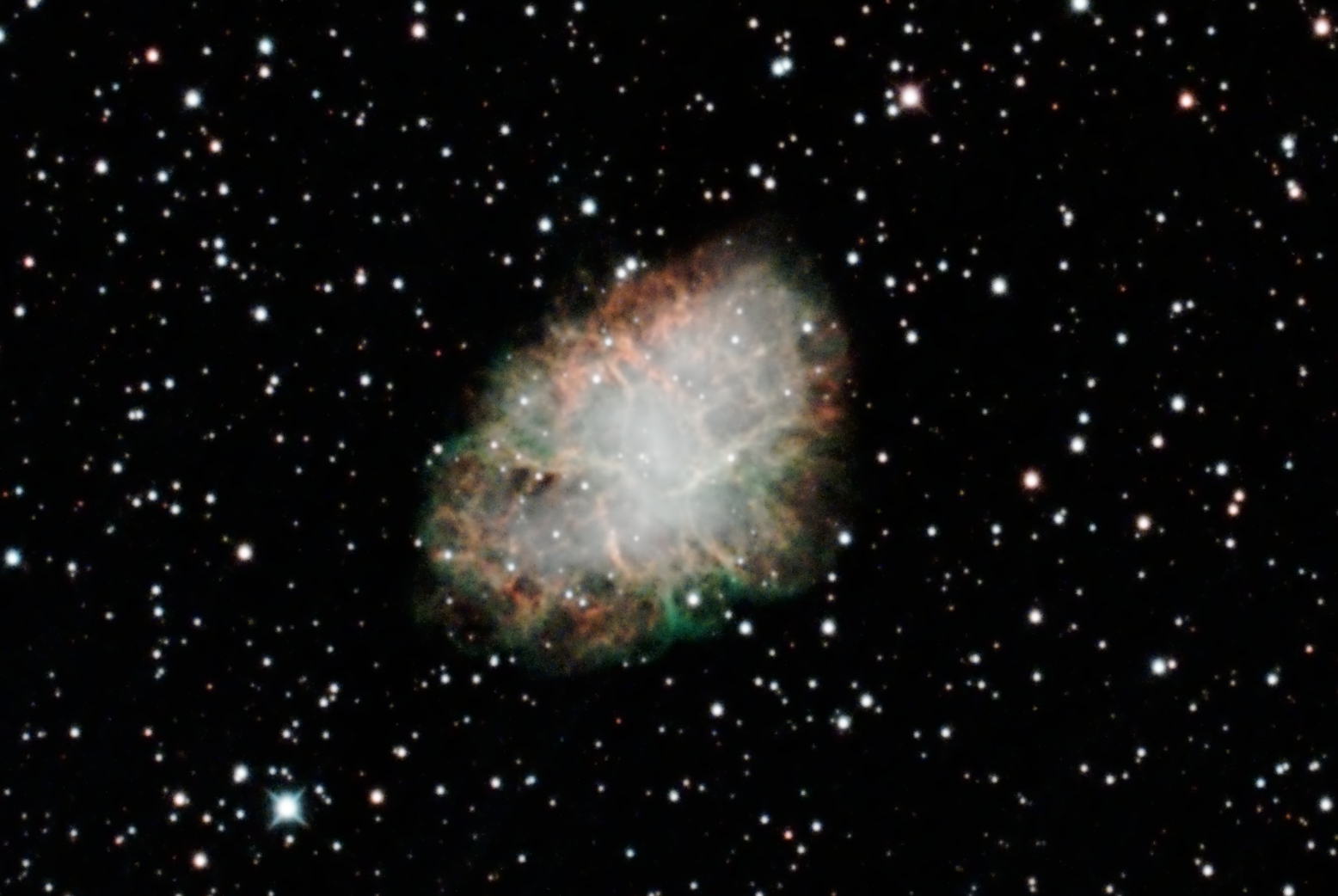
Derby and District Astronomical Society
Messier 1 (NGC 1952)
The Crab Nebula
Supernova Remnant in Taurus
RA 05h 34m 30s Dec +22° 01' 00"
| This image of the Crab Nebula was captured by Peter Branson on October 25th 2025, and produced from 80 x 60 second images. The images were captured using a ZWO ASI585MC colour camera attached to a Celestron C9.25 Schmitt-Cassegrain telescope, mounted on a SkyWatcher NEQ6 mount. The set of images was stacked in Nebulosity and imported into PixInsight for further processing and sharpening. Image Credit: Peter Branson. |
 |
| This image of the Crab Nebula (M1) was captured by Mike Lancaster on the 17th January 2024 and comprises 58 x 1 minute exposures taken using an Altair Hypercam 26C at 300 gain (plus darks, flats and flat darks), through an Orion Optics UK AG12 Astrograph mounted on an EQ8 mount. A 0.95x Wynne Corrector and Astronomik CLS-CCD filter were also employed. Guiding wasn't needed this time due to the relatively short exposures. Images were acquired using SharpCap, and the processing was entirely performed in PixInsight. The original image has been cropped quite a bit to focus on the nebula. Image Credit: Mike Lancaster. |
 |
| Mike Lancaster captured this image of The Crab Nebula on the 16th January 2023. It is a stack of eight 2 minute exposures taken using a Mallincam Universe camera at 22dB gain and full resolution through an Orion Optics UK AG12 astrograph. A 0.95x Wynne Corrector and Hutech IDAS LPS-D3 light pollution suppression filter were also employed. This setup was mounted on an EQ8 mount guided using a Lodestar camera using PHD2 through a piggybacked ST-80 refractor. The images were stacked in Deep Sky Stacker and processed in Nebulosity. No darks or flats were used. Image Credit: Mike Lancaster. |
 |
| This image of The Crab Nebula was captured by Mike Lancaster on the 11th January 2022. It is a stack of ten 8 minute exposures taken using a Mallincam Universe camera at 22dB gain and full resolution through a 10" Meade ACF SCT. A 0.5x Mallincam focal reducer and Astronomik CLS CCD filter were also used. This setup was mounted on an EQ8 mount guided using a Lodestar camera through an off axis guider using PHD2. The images were combined, cropped and processed in Nebulosity 4 and Photoshop Elements 2020. Image Credit: Mike Lancaster. |
 |
| Mike Lancaster captured this image of The Crab Nebula on the 9th January 2014 using a Mallincam Xtreme X2 camera, a 10" Meade LX200 ACF SCT, NEQ6 Pro mount, and a Mallincam MFR5 focal reducer at f/5. It is a stack of three 60 second hyper mode exposures with the amplifier gain (AGC) set at 5. No guiding was employed. The images were stacked and processed in Nebulosity v3 using the levels/power stretch function and a little bit of noise reduction. The image was further procesed in Photoshop Elements using Noel Carboni's Astronomy Tools to reduce some of the amp glow in the top left corner, reduce overall noise and darken the space background. Image Credit: Mike Lancaster. |
 |
|
This image of the Crab Nebula was captured by Adrian Brown in December 2006. It was created from 5 x 30 minute exposures with a 6 nm H-alpha filter. For imaging Adrian used an ATIK ATK16HR camera through a Skywatcher 80ED Pro refractor at f7.5. This was guided using an ATIK ATK-2HS camera through a Skywatcher 80T refractor. The set up was mounted on a Celestron CGE mount. Image Credit: Adrian Brown. |
 |
|
Chris Newsome and Adrian Brown produced the following image of The Crab Nebula on the 19th February 2006. They used a Canon EOS300 camera at 800 ASA through Adrian's Celestron C11 fitted with a f/6.3 focal reducer. This was set up on a CGE mount and guided using Guidedog software with focusing using DSLRFocus. An Astronomik CLS filter was also used to remove sodium light. Three images taken at 210 seconds exposure and calibrated in Maxim DL. The resulting image was processed in CS2 using RGB levels, curves, GradientXTerminator and a highpass filter. Image Credit: Chris Newsome and Adrian Brown.
|
 |
|
This image of The Crab Nebula was captured by Adrian Brown using the Rent a Scope Robotic Observatory in New Mexico on the 30th October 2005. He used a Takahashi Mewlon 300 on a Paramount mount and an SBIG ST8E camera to capture 13x 120 seconds high resolution luminance frames. Lower resolution RGB frames captured were 5x 60 seconds Red, 4x 60 seconds Green and 5x 90 seconds Blue. To process the image Adrian used Maxim DL 4 to align and stack the composite frames and then Adobe Photoshop to combine the luminance and RGB images into the final image. Adrian comments that "the seeing conditions in New Mexico weren't as good as the day before when I imaged Caldwell 23 (NGC 891) so this image is a little on the soft side and not as sharp. Having said that, compared to the UK it was still good observing conditions. It was fascinating to look at the webcam quality "all sky cam" image for the observatory and see the milky way arcing across the image. I can only imagine what it must be like to actually be there." As he states, Adrian has also taken a picture of Caldwell 23 (NGC 891) with this robotic telescope facility, where he also provides a review. Image Credit: Adrian Brown.
|
 |
[Top]